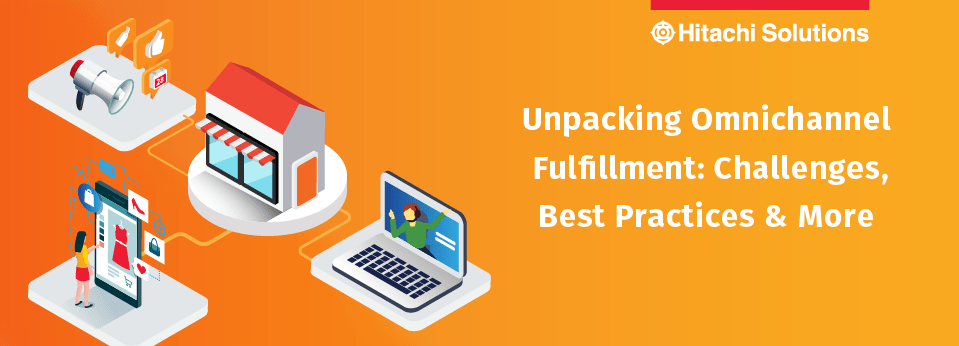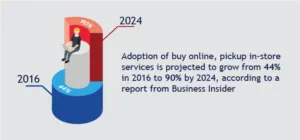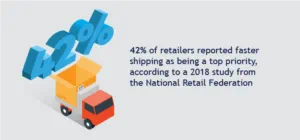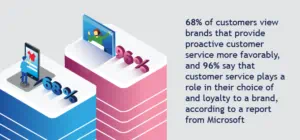

With closures of brick-and-mortar storefronts regularly making headlines, it sometimes seems like retail’s virtual future is all but inevitable — but studies suggest otherwise. Though younger generations of Americans show a clear preference for online shopping — almost 70% of millennials shop online, according to a report from Big Commerce — older generations continue to prefer in-store shopping, creating a fairly even demographic split. To keep up with the demand for omnichannel, retailers must create an intelligent supply chain and take a truly omnichannel approach to fulfillment.

Omnichannel Glossary
Omnichannel fulfillment: Describes the order fulfillment process across multiple channels, including brick-and-mortar stores, catalogs, social media, webstores, and online marketplaces. To achieve omnichannel fulfillment, retailers must connect these channels — for example, by consolidating stock from multiple channels into a single source of inventory — using omnichannel logistics solutions to deliver a truly seamless customer experience.
Omnichannel distribution, a key aspect of the omnichannel fulfillment process, refers to the means by which customers purchase and receive orders through the channel of their choosing. Omnichannel distribution also encompasses reverse logistics, such as product returns.
Omnichannel logistics: Logistics is a key component of supply chain management that “plans, implements, and controls the efficient, effective forward and reverse flow and storage of goods, services, and related information between the point of origin and the point of consumption,” according to the Council of Supply Chain Management Professionals. In brief, logistics is all about where the inventory for a product the customer wants is located, and how you intend to get that product to the customer.
Omnichannel logistics takes this basic premise and extends it across multiple channels. Certain retailers have even used technology to simplify omnichannel logistics and create a single inventory from which to pull items for online and in-store fulfillment alike.
Intelligent supply chain: According to Supply Chain Dive, an intelligent supply chain is one that is “capable of operationalizing data lakes to power decisions” and that combines “large-scale IoT infrastructures, deeper analytical processing and machine learning tools” to reimagine business intelligence processes. An intelligent supply chain is designed in such a way that it is possible for you — as well as all other entities involved in your omnichannel fulfillment process — to use data to make more accurate predictions and better plan for future needs.
The State of the Retail Industry
Retailers might be comforted to hear that, despite doomsayers’ insistence to the contrary, traditional retail is not at death’s door. In fact, a growing number of retailers are using their brick-and-mortar stores to enhance their ecommerce strategy, and vice versa. Take, for example, buy online, pickup in-store services, which give customers the flexibility to place orders from the comfort of their home and try on their purchase in-store. Adoption of buy online, pickup in-store services is projected to grow from 44% in 2016 to 90% by 2024, according to a report from Business Insider.

This is just one example of how retailers are leveraging technology to adapt to and resolve industry challenges, as well as enhance their omnichannel fulfillment performance. Let’s look at a couple more.
Inventory Visibility
Delivery speed is a major concern for retailers, so much so that 42% of retailers reported faster shipping as being a top priority, according to a 2018 study from the National Retail Federation. In order to provide faster shipping, retailers require accurate, up-to-date inventory visibility — that is, the ability to see exactly where their inventory is located at any given point in time, whether that’s at a distribution center, a retail location, or in transit.

Omnichannel logistics solutions such as enterprise resource planning (ERP) and warehouse management systems enable retailers to get a complete picture of their inventory, including which items are in stock and where they’re located within the supply chain. This improved inventory visibility also comes with the added benefits of more accurate demand forecasting and smarter resource allocation and contributes to better overall omnichannel fulfillment performance.
Inventory Consolidation
The more channels a retailer has, the more those channels will compete for inventory. For example, when a certain item is in high demand and regularly sells out, a retailer must decide whether to prioritize in-store purchases or online order fulfillment for that item. The cost of maintaining inventory across multiple locations (store stock rooms, distribution centers, regional distribution centers, and so on) can also be a pain point for omnichannel retailers.
Rather than cut costs at the expense of inventory, or vice versa, retailers must find a way to proactively manage inventory levels in a way that keeps costs low while continuing to meet customer expectations. One way is to move from a multi-tier inventory optimization model to a single-tier model, so that resources can be distributed equally, and costs reduced in the process.
Customer Satisfaction
The impetus for this focus on delivery speed is customer satisfaction. Customer satisfaction has been a perennial issue for the retail industry because customer expectations frequently change. Although it’s important for retailers to stay up to date on the latest industry trends and how they affect customer expectations, the easiest way to improve overall customer satisfaction is to go back to basics, but with an omnichannel approach.
Faster delivery is one way to achieve this; proactive customer service is another. As the retail customer experience expands across multiple channels, so, too, have retailers’ modes of communication. Live chat modules give customers the opportunity to connect with a brand’s customer service team in real time as they shop online, while chatbots enable customers to engage in self-service, if they so choose.
For a truly omnichannel experience, retailers can equip in-store sales associates with mobile technology with ERP and customer relationship management (CRM) systems so they can provide tailored recommendations, view inventory without having to go into the stock room, respond to customer questions, and quickly resolve any issues that might arise. When properly executed, an omnichannel approach to customer satisfaction has the power to pay off in dividends: 68% of customers view brands that provide proactive customer service more favorably, and 96% say that customer service plays a role in their choice of and loyalty to a brand, according to a report from Microsoft .

The Omnichannel Buyer’s Journey
While scrolling through his feed one afternoon, Andrew comes across an Instagram ad for sneakers that catches his attention. He opens his laptop to look up the retailer’s brand and prices for the sneakers, as well as browse additional styles. He decides that he likes two different pairs and places an order with in-store pickup at the brick-and-mortar location near his office, so he can try them on after work.
While trying the sneakers on, Andrew mentions that he has high arches to the sales associate, who recommends an insole insert designed for arch support. Andrew decides to purchase both pairs of sneakers, as well as the inserts, which are sold out in his shoe size. The sales associate quickly places an order for the inserts in their company’s ERP system and requests that the item be sent to Andrew’s house using next-day delivery. When Andrew gets home from work the next day, he finds a package that contains the inserts waiting for him on his front doorstep and is able to wear his new sneakers when he goes out to meet up with friends that night.
This is a perfect example of how customers engage with brands across multiple channels, as well as how retailers can capitalize on omnichannel fulfillment strategies: Andrew became aware of the product and the brand through social media, conducted additional research and placed an order through the retailer’s online store, and visited in-store to try on the product. The sales associate then identified an opportunity to cross-sell, increasing their employer’s total revenue, and improved Andrew’s experience by using an intelligent omnichannel logistics solution with inventory visibility to get him the product he needed.
Omnichannel Fulfillment & Logistics in Action
Imagine, for a moment, that you own a T-shirt company that is based in the Midwest and has both brick-and-mortar locations and an ecommerce site. A customer from Illinois orders one of your shirts online, and you see that you have that particular product in stock in one of your stores in Indiana and in your distribution center in Kansas. Although the store in Indiana is closer to the customer, which would save you shipping costs and get the product to the customer that much faster, you don’t want to deplete stock. Therefore, it makes more sense to ship the product from the distribution center in Kansas.
Now that you’ve decided where to source your inventory from, it’s time to figure out how to get it to the customer. Fortunately, with today’s technology, it’s possible to create rules and filters for inventory stocking levels, freight costs, delivery dates, and more. You can prioritize these rules according to your needs, thereby enabling you to reduce costs wherever possible. In this case, your omnichannel fulfillment system would recognize that the customer paid extra to expedite the shipping process and automatically compare contracts to see which shipping carrier can get the product to the customer the fastest, at the lowest cost to you.
Modern solutions also utilize data science and machine learning to help retailers model past history and forecast new purchase behaviors to either validate rules or prioritize rules, as well as update stocking levels and merchandize mixes to optimize future omnichannel fulfillment.
Omnichannel Fulfillment Best Practices
In order to realize the benefits of omnichannel fulfillment, there are a few best practices retailers should observe:;
- Choose the right omnichannel fulfillment strategy. With so many options from which to choose — ship-from-store, ship-from-3PL, ship-from-partner, and so on — it’s important that retailers select the one that best meets their business needs.
- Break down silos. Operational and departmental silos are the mortal enemy of omnichannel fulfillment, so retailers are advised to encourage integration and collaboration whenever possible.
- Practice good inventory management. Maintain detailed inventory records, develop a company-wide parts entry protocol, organize products in such a way that they’re easily accessible, automate essential workflows, and utilize systems that increase inventory visibility to ensure that your products are in the right place at the right time.
- Invest in the right technology. Inventory management and warehouse management systems take omnichannel fulfillment from a complex endeavor — one that entails inventory management, sortation, picking and packing, shipping management, product replenishment, and more — and distill it into a much simpler, more efficient process.
Benefits of Working With a 3PL
Outsourcing omnichannel supply chain operations to a third-party logistics (3PL) provider is an easy way to reduce some of the complexities and defray some of the costs associated with omnichannel fulfillment.
Dedicated 3PL providers have the knowledge, experience, and technology to simplify your supply chain, enhance omnichannel performance, reduce operational and functional support risks, and to help you grow your business. Although the idea of handing control over their supply chain operations to a third-party provider might seem intimidating to some companies, with the right provider, the benefits far outweigh the risks.
Next Steps to Get Started
Whatever your omnichannel fulfillment challenge, whether its high freighting and carrying costs or difficulty balancing your inventory, pick up in store, Hitachi Solutions can help. We specialize in providing fulfillment solutions based on our clients’ rules engines to reduce freight costs and dismiss out of stock conditions. Our years of experience working with retailers such as yourself to apply data science and machine learning to optimize inventory while maintaining customer satisfaction make us uniquely qualified to handle any omnichannel fulfillment project, no matter the scale. Reach out to the experts at Hitachi Solutions today to kickstart your omnichannel journey


